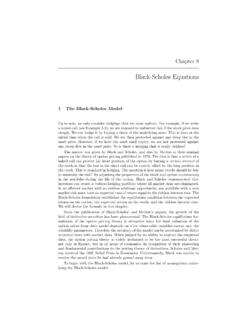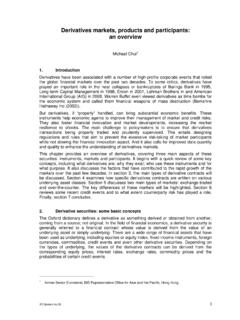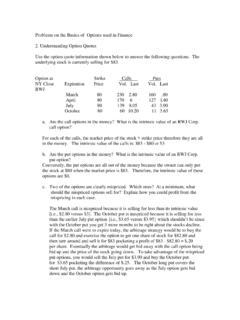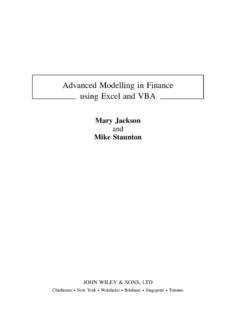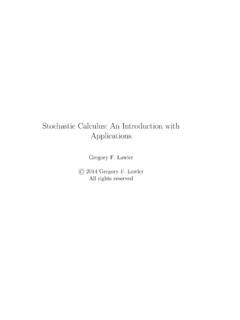Transcription of The Black-Scholes Formula - Tim Worrall
1 FIN-40008 FINANCIAL INSTRUMENTSSPRING 2008 The Black-Scholes FormulaThese notes examine the Black-Scholes Formula for European options. TheBlack- scholes Formula are complex as they are based on the geometric Brow-nian motion assumption for the underlying asset price. Nevertheless theycan be interpreted and are easy to use once understood. We start off byexamining digital or binary options which are easy and intuitive to shall show how the Black-Scholes Formula can be derived and derive andjustify the Black-Scholes -Merton partial differential : Black-Scholes Formula , Black-Scholers-Merton partial differen-tial equation, replication, self-financing portfolio, martingale pricing , bound-ary conditions, : Hull Chapter OptionsTo help understand the Black-Scholes Formula for call and put options westart by looking at digital options.
2 Digital options are very simple. A digitalcall with a strike priceKand maturity dateTpays out one unit ifS(T)> Kand nothing otherwise. Likewise a digital put with a strike priceKandmaturity dateTpays out one unit ifS(T)< Kand nothing for a digital call option the payoff at maturity is:cb(T) = 0 ifS(T) K1 ifS(T)> K12 BLACK-SCHOLESand the payoff at maturity to a digital put option is:pb(T) = 1 ifS(T) K0 ifS(T)> now show how to value the digital call option. The end priceSTis arandom variable. We have by assumption that lnS(T) is normally distributedwithE[lnS(T)] = lnS(0) +( 12 2)TandVar[lnS(T)] = (T) lnS(0) ( 12 2)T Tis a standard normal variable with expected value of zero and standard devia-tion of one. We want to know the probability that the call option is call option is exercised ifST> Kor equivalently if lnS(T)>lnK.
3 Thusthe probability of exercise is given by 1 N(x ) wherex =lnK lnS(0) ( 12 2)T TAs we have seen options can be evaluated using risk-neutral pricing , that isas if all assets earn the same rate of return,ras the riskless asset. Thus wereplace byrin the above equation to getx=lnK lnS(0) (r 12 2)T the probability of exercise in a risk-neutral world is 1 N(x) =N( x).The call option pays out one unit if it is exercised but only the expected discounted value of the digital call option iscb(0) =e rTN( x).FIN-40008 FINANCIAL INSTRUMENTS3 There is a simple condition for put call parity for digital options. This isgiven bycb(0) +pb(0) =e rTsince if one buys a digital call and a digital put with the same strike priceand maturity date, one is sure to have one unit at timeTno matter whatthe price of the underlying asset. Hence the put price satisfiespb(0) =e rT cb(0) =e rT e rTN( x) =e rT(1 N( x)) =e rTN(x).
4 Equivalently we can see that the risk-neutral probability thatST< Kisgiven byN(x) and hence the value of the binary or digital put ise rTN(x)wherexis given Black-Scholes FormulaPlain options have slightly more complex payoffs than digital options but theprinciples for calculating the option value are the payoff to a European call option with strike priceKat the maturitydateTisc(T) = max[S(T) K,0]whereS(T) is the price of the underlying asset at the maturity date. Atmaturity ifS(T)> Kthe option to buy the underlying atKcan be exercisedand the underlying asset immediately sold forS(T) to give a net payoff ofS(T) K. Since the option gives only the right and not the obligation to buythe underlying asset, the option to buy the underlying will not be exercisedif doing so would lead to a loss,S(T) K <0. The Black-Scholes formulafor the price of the call option at datet= 0 prior to maturity is given byc(0) =S(0)N(d1) e rTKN(d2)whereN(d) is the cumulative probability distribution for a variable that hasa standard normal distribution with mean of zero and standard deviation of4 BLACK-SCHOLESone.
5 It is the area under the standard normal density function from todand therefore gives the probability that a random draw from the standardnormal distribution will have a value less than or equal tod. We have there-fore that 0 N(d) 1 withN( ) = 0,N(0) =12andN(+ ) = 1. Thetermris the continuously compounded risk-free rate of interest andd1andd2satisfyd1=ln(S(0)K) + (r+12 2)T Td2=d1 T=ln(S(0)K) + (r 12 2)T THere 2is the variance of the continuously compounded rate of return on theunderlying the payoff to a European put option with strike priceKat thematurity dateTisp(T) = max[K S(T),0]as the put option gives the right to sell underlying asset at the strike price ofK. The Black-Scholes Formula for the price of the put option at datet= 0prior to maturity is given byp(0) =c(0) +e rTK S(0) =e rTK(1 N(d2)) S(0)(1 N(d1))whered1andd2are defined above.
6 By the symmetry of the standard normaldistributionN( d) = (1 N(d)) so the Formula for the put option is usuallywritten asp(0) =e rTKN( d2) S(0)N( d1).Interpretation of the FormulaRewrite the Black-Scholes Formula asc(0) =e rT(S(0)erTN(d1) KN(d2)).FIN-40008 FINANCIAL INSTRUMENTS5 The Formula can be interpreted as follows. If the call option is exercised atthe maturity date then the holder gets the stock worthS(T) but has to paythe strike priceK. But this exchange takes place only if the call finishes inthe money. ThusS(0)erTN(d1) represents the future value of the underlyingasset conditional on the end stock valueS(T) being greater than the strikepriceK. The second term in the bracketsKN(d2) is the value of the knownpaymentKtimes the probability that the strike price will be paidN(d2). Theterms inside the brackets are discounted by the risk-free raterto bring thepayments into present value terms.
7 Thus the evaluation inside the bracketsis made using the risk-neutral or martingale probabilities. The termN(d2)represents the probability that the call finishes in the money whered2is alsoevaluated using the risk-free that in a risk-neutral world all assets earn the risk-free are assuming the the logarithm of the stock price is normally the expected continuously compounded rate of return in a risk neutralworld is equal tor 12 2where the variance is deducted to calculate thecertainty equivalent rate of return. Therefore at timeTlnS(T) is normallydistributed with a mean value of lnS(0)+(r 12 2)Tand a standard deviationof T. ThuslnS(T) (lnS(0)) + (r 12 2)T) Tis a standard normal variable. The probability thatS(T)< Kis thereforegiven byN( d2) and the probability thatS(T)> Kis given by 1 N( d2) =N(d2).It is more complicated to show thatS(0)erTN(d1) is the future value ofunderlying asset in a risk-neutral world conditional onS(T)> Kbut a proofcan be found in more advanced Formula also has another useful interpretation.
8 From our analysis ofthe binomial model we know that the value of the call isc(0) =S(0) B6 Black-Scholes where is the amount of the underlying asset bought andBis the amountof money borrowed needed to synthesize the call option. From the for-mula thereforeN(d1) is the hedge parameter indicating the number of sharesbought ande rTKN(d2) indicates the amount of cash borrowed to part fi-nance the share purchase. Since 0 N(d) 1 the Formula shows thatthe replicating portfolio consists of a fraction of the underlying asset and apositive amount of cash borrowed. The of this Formula is also found bypartially differentiating the call price Formula c(0) S(0)= .It is the slope of the curve relating the option price with the price of theunderlying asset. The cost of buying units of the stock and writing onecall option isS(0) c(0).
9 This portfolio is said to bedelta neutralas asmall change in the stock price will not affect the value of the ConditionsWe shall consider the boundary conditions for the call option. Consider firstthe boundary condition for the call at expiration whenT= 0. To do thisconsider the Formula for the call option asT 0, that is as the time untilmaturity goes to zero. At maturityc(T) = max[S(T) K,0] so we need toshow that asT 0 the Formula converges toc(0) = max[S(0) K,0]. IfS(0)> Kthen ln(S(0)K)>0 so that asT 0,d1andd2 + . ThusN(d1)andN(d2) 1. Sincee rT 1 asT 0 we have thatc(0) S(0) KifS(0)> K. Alternatively ifS(0)< Kthen ln(S(0)K)<0 so that asT 0,d1andd2 and henceN(d1) andN(d2) 0. Thusc(0) 0 ifS(0)< K. This is precisely as expected. If the option is in the money atmaturity,S(0)> K, it is exercised for a profit ofS(0) Kand if it is out ofthe money,S(0)< K, the option expires unexercised and FINANCIAL INSTRUMENTS7As another example consider what happens as 0.
10 In this case theunderlying asset becomes riskless so grows at the constant rate ofr. Thusthe future value of the stock isS(T) =erTS(0) and the payoff to the calloption at maturity is max[erTS(0) K,0]. Thus the value of the call at datet= 0 is max[S(0) e rTK,0]. To see this from the Formula first consider thecase whereS(0) e rTK >0 or ln(S(0)K) +rT >0. Then as 0,d1andd2 + and henceN(d1) andN(d2) 1. Thusc(0) S(0) e whenS(0) e rTK <0 or ln(S(0)K) +rT <0 thend1andd2 as 0. HenceN(d1) andN(d2) 0 and soc(0) 0. Thus combiningboth conditionsc(0) max[erTS(0) K,0] as OptionsConsider an option that is currently at-the-money,S(0) =K. Then theformula for the call option becomesc(0) =S(0)(N(d1) e rTN(d2))whered1=(r 12 2)T T;d2=d1 the price of an at-the-money call option is simply a fraction the priceof the is an even more convenient approximation if we takeK=S(0)erT,that is where the strike price is forward price of the underlying asset.

